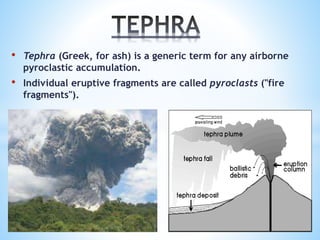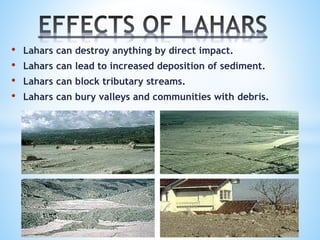Volcanic products (2)
- 1. ŌĆó Tephra (Greek, for ash) is a generic term for any airborne pyroclastic accumulation. ŌĆó Individual eruptive fragments are called pyroclasts ("fire fragments").
- 2. 1) ASH :- ŌĆó Very fine-grained fragments (< 2 mm). ŌĆó Dominated by broken glass shards.
- 3. 2) LAPILLI :- ŌĆó Pea- to walnut-size pyroclasts (2 to 64 mm). ŌĆó Often look like cinders. ŌĆó Rounded spheres known as accretionary lapilli are formed in water rich eruptions.
- 4. 3) BLOCKS AND BOMBS :- ŌĆó Fragments >64 mm. ŌĆó Blocks are ejected as solid fragments with angular shapes.
- 5. ŌĆó PELE'S TEARS :- Lapilli-size fragments of basaltic lava may cool quickly while airborne, to form glassy teardrop-shaped lapilli called Pele's tears. ŌĆó PELEŌĆÖS HAIR :- During strong winds, the molten fragments that can be drawn out into fine filaments are called Pele's hair. ŌĆó SPATTER :- They are lapilli- to bomb-size fragments produced by Non-explosive Hawaiian-type eruptions.
- 6. ŌĆó PUMICE :- They are produced from vigorous gas escape in felsic lavas. ŌĆó RETICULITE :- They are produced from similar gas escape in mafic lava. ŌĆó SCORIA :- A denser mafic rock containing a smaller abundance of relatively large vesicles.
- 7. ŌĆó Scoria-fall deposits :- These are derived from Strombolian eruptions of scoria cones. The deposit is composed of basaltic to andesitic vesiculated pyroclasts (scoria) lying near the eruptive vent. ŌĆó Pumice-fall deposits :- These are derived from Plinian eruptions of stratovolcanoes. The deposit is composed of highly vesiculated dacitic to rhyolitic pyroclasts (pumice) which can be distributed for hundreds of square kilometers away from the vent.
- 8. ŌĆó Ash tuff - rock dominated by ash; sometimes simply referred to as tuff. ŌĆó Lapilli tuff - rock dominated by lapilli. ŌĆó Tuff breccia - rock containing 25% to 75% blocks and/or bombs. ŌĆó Pyroclastic breccia - rock containing at least 75% blocks and bombs. ŌĆó Agglomerate - rock containing at least 75% bombs. ŌĆó Agglutinate - rock composed of fused, largely unrecognizable, basalt spatter fragments.
- 9. ŌĆó Fluidized mixture of solid to semi-solid fragments and hot, expanding gases that flows down the flank of a volcanic edifice. ŌĆó Heavier-than-air emulsions that move much like a snow avalanche. ŌĆó Most deadly of all volcanic phenomena.
- 11. ŌĆó Indonesian term for a volcanic mudflow. ŌĆó Lethal mixtures of water and tephra have the consistency of wet concrete. ŌĆó Maximum temperature of a lahar is 100 degrees Centigrade.
- 13. ŌĆó Majority are produced by intense rainfall during or after an eruption. ŌĆó A tragic example of such an event was the 1991 eruption of Mt. Pinatubo in the Philippines. An estimated 700 people died from burial by the ensuing lahars, together with the collapse of structures beneath the wet ash.
- 14. ŌĆó Lahars can destroy anything by direct impact. ŌĆó Lahars can lead to increased deposition of sediment. ŌĆó Lahars can block tributary streams. ŌĆó Lahars can bury valleys and communities with debris.














